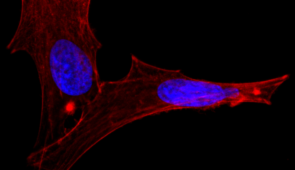We do not know if the backlands will ever turn into an ocean, as Antônio Conselheiro prophesied, but science has proven that at least part of that territory would actually relive the past in case the prediction of the popular leader came true. Located in the south of Ceará, the Cariri region was once in contact with the ocean and nowadays it is fertile ground for new paleontological findings.
In a matter of months, important findings from UFC researchers gained prominence in international journals, unveiling aspects of the prehistoric Cariri, such as the discovery of a new plant and the surfacing of morphological data about a shrimp that inhabited the region a long time ago.
Between 110 and 115 million years ago, in the Cretaceous period, the Earth was undergoing a profound transformation. The Jurassic period was over and the huge dinosaurs were being replaced by smaller species. The first flowering plants had appeared a few million years prior to that moment and the land that nowadays corresponds to South America was slowly drifting away from Africa, making room for the South Atlantic Ocean. The climate was increasingly warm, partly due to the intense volcanic activity.
To solve this puzzle, we must gather millions of small pieces: fossils of animals and plants, which give us clues about the world in that period. The exceptional geological and environmental conditions of the Cariri region originated the
Santana Group, one of the most important paths to understand the Cretaceous.
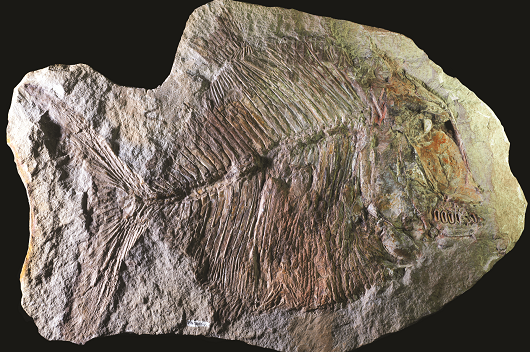
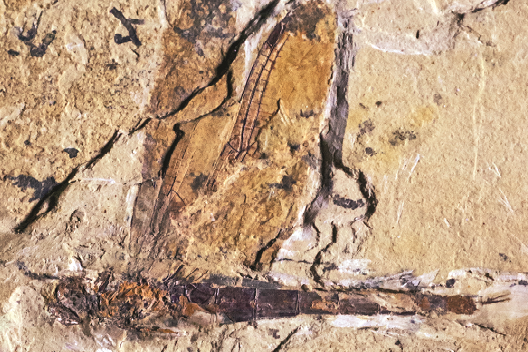
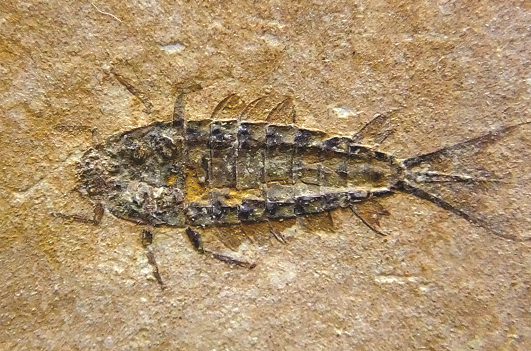
The several rock layers indicate the profound changes the area went through. Some of them were formed at the bottom of a gigantic lake, a paleolake, which is the case of the Crato Formation, a layer of sediments mainly composed of laminated limestone (Cariri stone). After several environmental changes, the paleolake turned into a lagoon system that, somehow, came into contact with marine water. This sediment deposition process originated the Romualdo
Formation, which is known worldwide for preserving fossils in three-dimensional limestone concretions.
The geological records show that, due to the decrease in the sea level, the region turned into a place of large and still-water rivers, which silted up the Araripe basin. At some point, the period’s intense tectonic activity caused the upland of the entire area, lifting the bottom of the basin and forming the Araripe plateau.
Embedded in these rocks, the fossils have become photographs of that past and what they show us is a Cariri inhabited by a diverse fauna. More than 60 genera of vertebrates have been cataloged so far. There were dinosaurs, like the carnivore Santanaraptor, and more than 20 species of pterosaurs. There are also numerous records of fishes, turtles, and crocodylomorphs, such as Caririsuchus and Araripesuchus. Insects are counted by the dozens: crickets,
dragonflies, cockroaches, wasps, and prehistoric ants, as well as rare shrimp fossils.
THE PIECES OF A PUZZLE
It is in this unusual environment, with very particular conditions, that scientists strive to find one more piece of this puzzle. At the end of the last year, a group of researchers identified a new plant species in the Crato Formation:
Brachyphyllum sattlerae. The group studied fossilized leaf fragments and identified significant anatomical
differences from those already known in the region, such as Brachyphyllum obesum, one of the most abundant plant fossils in the formation. The anatomy details, especially the epidermis and its morphology, led to the conclusion that
they were dealing with a new species.
Vegetables are particularly important since they are great indicators of environmental aspects. Both B. obesum and B. sattlerae, for instance, are from the conifer plant group, specifically from the Araucariaceae family. Indeed,
distant relatives of the current pine trees, which are typical to the southern region of the country, were commonly found in the Araripe basin. Since only leaf fragments were found in the fossil, it is not possible to know the size of the tree, but it is possible to assume it was large.
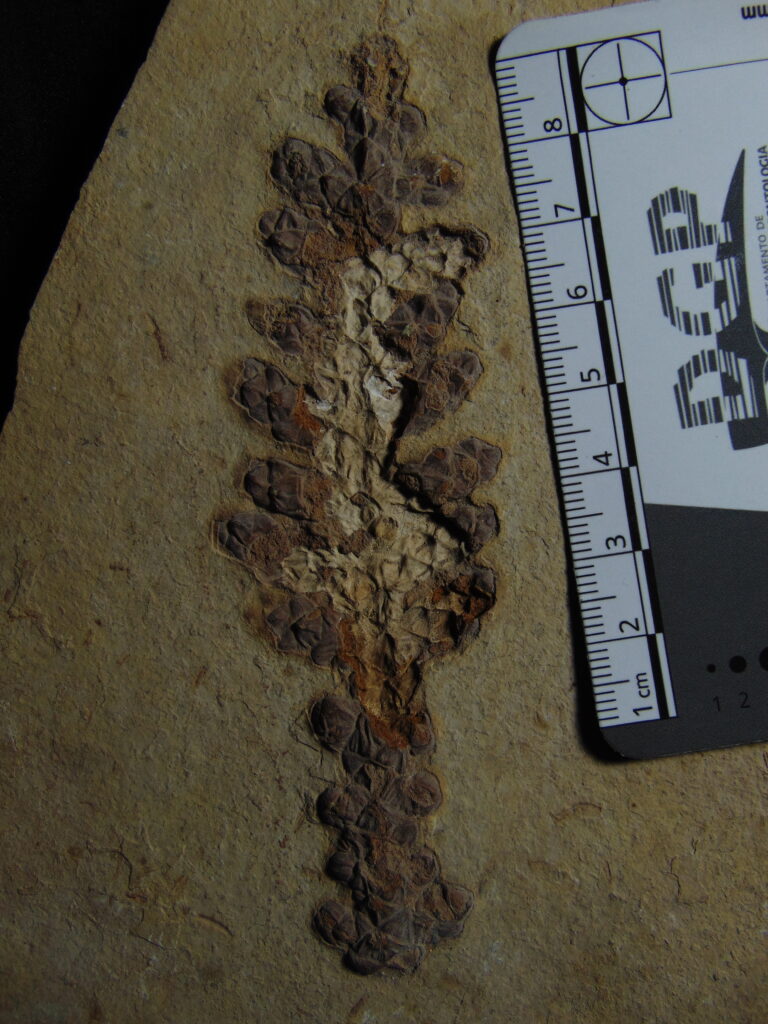
The microscopic analysis makes it possible to identify clues about the climate. The sunken stomata are structures in the epidermis of leaves responsible for gas exchange, and when it comes to the B. sattlerae they reinforce the hypothesis raised by paleontologists: the plant lived in a low humidity environment and the climate of the region was either arid or semi-arid.
Does it seem strange for a plant thought to be an araucaria? “No, not really”, says Maria Edenilce Peixoto Batista, a researcher at the Graduate Program in Ecology and Natural Resources of the UFC College of Sciences and one of the
authors of this study. She explains that one of the characteristics of the araucaria is precisely being able to adapt to the lack of water, whether it is caused by aridity or low temperatures that end up freezing the water.
According to the researcher, it is not possible to know where these trees were located in the basin. It is believed that these plants lived on hills far from the lake and that, at some point, the branches ended up in the aquatic environment, where the process of fossilization occurred and, thereafter, their incorporation into the rock layers that were revealed with the upland of the basin.
In addition to Professor Edenilce, other members of the group of researchers are Maria Iracema Bezerra Loiola, Professor at the Department of Biology of the UFC College of Sciences; Antônio Saraiva, from the Regional University of Cariri (URCA); Lutz Kunzmann, from Senckenberg Natural History Collections (Germany); and Artur Sá, from the University of Trás-os-Montes e Alto Douro (Portugal). The research was published in December 2020 in Ameghiniana, one of the main paleontology journals in Latin America.
There is also a fun fact about the name of the new species: sattlerae is a reference to the paleobotanist Ellie Sattler, a character in Jurassic Park, played by Laura Dern. Professor Edenilce considers this a way of drawing attention to
the importance of women in science, in addition to popularizing the branch of paleontology that studies plants.
This study was financed in part by the Coordenação de Aperfeiçoamento de Pessoal de Nível Superior – Brasil (CAPES); the Conselho Nacional de Desenvolvimento Científico e Tecnológico (CNPq); the Fundação Cearense de Apoio ao Desenvolvimento Científico e Tecnológico (Funcap); and the Serviço Alemão de Intercâmbio Acadêmico (DAAD).
A PREHISTORIC SHRIMP
However, the Araripe basin is not just abundant in flora. Olga Alcântara Barros, a researcher at the Graduate Program in Geology of the UFC Science Center, has just published a paper in Plos One with a Qualis A1 rating. The article presents new data about the Beurlenia araripensis, a prehistoric shrimp that is already extinct and lived in freshwater.
The research is part of Olga’s Ph.D. thesis, supervised by Professor Maria Somália Viana in collaboration with professors Alexandre Paschoal (UFC); João Hermínio da Silva, from the Federal University of Cariri; and Paulo Victor de Oliveira and Bartolomeu Cruz Viana, both from the Federal University of Piauí. The study was funded by the Coordenação de Aperfeiçoamento de Pessoal de Nível Superior – Brasil (CAPES).
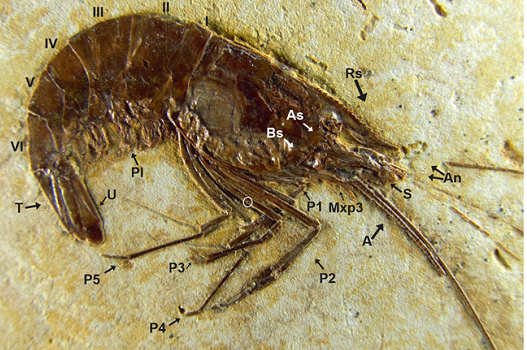
Shrimp fossils are difficult to find worldwide since they decompose very quickly, most of the time even before the fossilization process ends. In this case, Beurlenia has been a known species for years, but some data on its anatomy were partially inconclusive because the studied fossils were not well preserved. Science first described its rostrum (the front part of the shrimp’s head) as having four spines, but this structure was fragmented and incomplete in the fossil. The second description, made years later, documented that the shrimp had 11 rostral spines.
The Araripe basin was the path the researchers decided to follow in order to answer these questions. From there, they studied 13 fossils of this species distributed between the UFC’s Paleontology Laboratory collection, the technical reserve of the Plácido Cidade Nuvens URCA Museum of Paleontology, and the scientific collection of the Federal University of Rio de Janeiro.
As well as the newly discovered vegetable species, the specimens of this prehistoric shrimp are from the Cretaceous period and were fossilized in the Crato Formation, in the Araripe paleolake. Using modern equipment, researchers were able to unprecedentedly identify that the Beurlenia has a range of 5 to 14 spines in the rostral region, which is something that scientists call “morphological plasticity”. “This variation is commonly observed only in the Palaemonidae family, with current representatives of the genera Macrobrachium and Palaemon”, Olga explains.
In addition to the divergence in the number of rostrum spines, the detailed research identified that this species is also characterized by the presence of spines and tubercles in the pereopods (thoracic limbs). “The new fossil specimens that were studied and presented in this research constitute the pieces that were missing in this species’ identification puzzle”, researcher Olga Alcântara tells Agência UFC.
“For us, every discovered fossil is important because, through these preserved records, it is possible to reconstruct part of a scenario of how life was in the old world. Oftentimes, a certain fossil is a unique representative that carries all the information needed to fill in a blank in the scientific knowledge”, she adds. It is worth mentioning that, in recent years, several other studies have been carried out in the Araripe basin under the supervision of Professor Somália Sales Viana, in partnership with other universities. One of the discoveries was the first occurrence of caridean shrimp in the Ipubi Formation.
The paper, which results from a partnership with the Regional University of Cariri, was published in 2020 in the Research, Society and Development journal. In 2019, they also carried out studies using spectroscopy techniques on two shrimp fossils found in the Ipubi and Romualdo formations. From those, the researchers inferred data about the fossilization process and depositional environment in the stratigraphic levels of the Araripe basin. Both papers were
part of the research results of the Ph.D. student, Olga Alcântara
(in collaboration with Sérgio de Souza).
Sources: Olga Alcântara Barros, from the UFC Graduate Program in Geology – email address: olga.a.barros@gmail.com; Edenilce Batista, from the Graduate Program in Ecology and Natural Resources of the UFC Department of Biology – email address: edenilcebio@hotmail.com
Translation: Isabelly Maia – Research Assistant at UFC’s Translation Laboratory (LETRARE/PROINTER)


